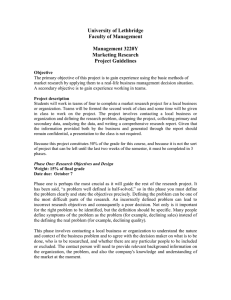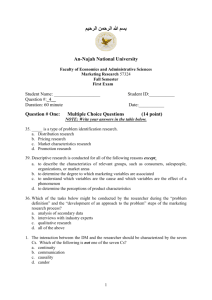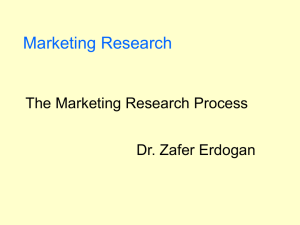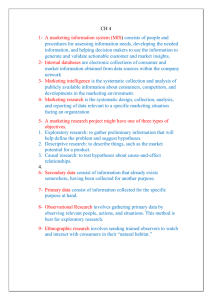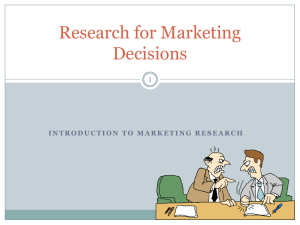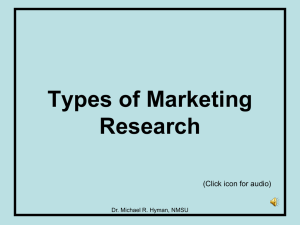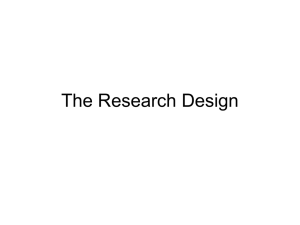(Chapter 3 Marketing Rsh Process)
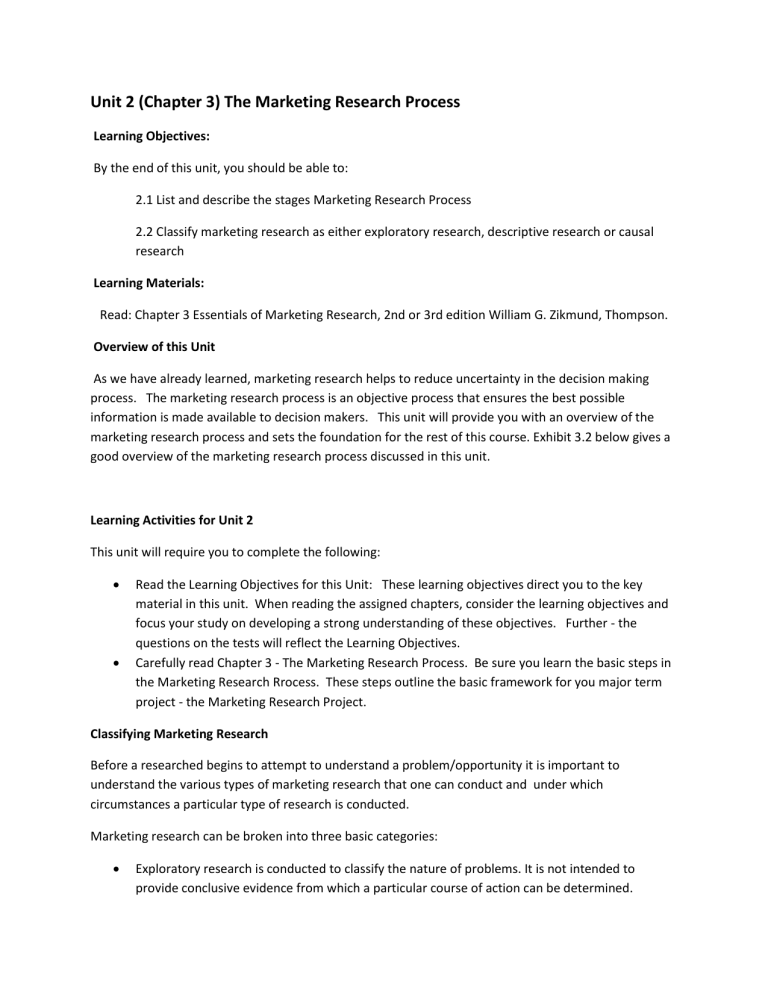
Unit 2 (Chapter 3) The Marketing Research Process
Learning Objectives:
By the end of this unit, you should be able to:
2.1 List and describe the stages Marketing Research Process
2.2 Classify marketing research as either exploratory research, descriptive research or causal research
Learning Materials:
Read: Chapter 3 Essentials of Marketing Research, 2nd or 3rd edition William G. Zikmund, Thompson.
Overview of this Unit
As we have already learned, marketing research helps to reduce uncertainty in the decision making process. The marketing research process is an objective process that ensures the best possible information is made available to decision makers. This unit will provide you with an overview of the marketing research process and sets the foundation for the rest of this course. Exhibit 3.2 below gives a good overview of the marketing research process discussed in this unit.
Learning Activities for Unit 2
This unit will require you to complete the following:
Read the Learning Objectives for this Unit: These learning objectives direct you to the key material in this unit. When reading the assigned chapters, consider the learning objectives and focus your study on developing a strong understanding of these objectives. Further - the questions on the tests will reflect the Learning Objectives.
Carefully read Chapter 3 - The Marketing Research Process. Be sure you learn the basic steps in the Marketing Research Rrocess. These steps outline the basic framework for you major term project - the Marketing Research Project.
Classifying Marketing Research
Before a researched begins to attempt to understand a problem/opportunity it is important to understand the various types of marketing research that one can conduct and under which circumstances a particular type of research is conducted.
Marketing research can be broken into three basic categories:
Exploratory research is conducted to classify the nature of problems. It is not intended to provide conclusive evidence from which a particular course of action can be determined.
Exploratory research merely crystallizes the problem and identifies information needed— subsequent research is usually required.
Descriptive research is conducted to discover and determine the characteristics of a population.
It seeks to determine the answers to the questions “who,” “what,” “when,” “where,” and
“how.” It does not tell us “why.” Although it is impossible to completely eliminate error, this type of research should be conducted as accurately as possible because, unlike exploratory research, the evidence it provides will be used to determine a course of action.
Causal research attempts to identify cause-and-effect relationships between variables. It usually follows exploratory and descriptive research and, therefore, the researchers are quite knowledgeable about the subject. Causal research attempts to establish that when we do one thing (e.g., lower prices), another will follow (e.g., increased sales). Determining a cause and effect relationship should be done with great care, other factors may be influencing why things are happening as they are. (e.g. Canadian Tire may offer a sale on snow blowers in a given week
– they notice that sales of snow blowers doubled over the same period last year. Was it the sale that caused the increased sale? Maybe – but maybe not – if there was a snowstorm in that same week that could have had a major influence in the sales jump! In this case the snowstorm would be considered a concomitant variation where the occurrence of the two phenomena or events vary together)
Marketing Research Process -Step 1 - Problem Discovery & Definition
Research programs are often begun because decision makers are uncertain about some aspect of the firm’s marketing program.
Most research will be conducted using a combination of four basic techniques: experience survey, secondary data, case studies, and pilot studies.
Experience Surveys rely on discussing the current problem/opportunity with experts or people with significant experience in the industry/field. Buy building on their experience researchers will better understand the problems and opportunities in the situation currently being studied.
Secondary data or historical data is data previously collected and assembled for some project other than the one at hand. Primary data, on the other hand, is gathered specifically for the project at hand.
Secondary data can often be found inside the company, at public libraries and universities, or purchased
from a firm specializing in providing information. Secondary data can usually be gathered faster and at less cost than primary data, but it can be outdated or may not exactly fit the researcher’s needs.
Case Studies rely on obtaining information from one or a few similar situations to the current research problem’s situation. A case study allows a research to see “what other people did and how it turned out” to learn from the mistakes and build on the successes of others.
Pilot studies collect data from the ultimate consumer, or the actual subject of the research project, to serve as a guide for the larger study. The data collection methods are informal and findings may lack precision, but may suggest possible topics for formal investigation. A pilot study may also consist of a
Focus Group interview, which is a loosely structured group dynamics session; it may use Projective
Techniques, in which certain tools/tests are used to allow for indirect discovery of an individulal's attitudes and beliefs; it may use In-Depth Interviews to obtain a deeper understanding of an individuals motivations.
Marketing Research Process - Step 2 – Planning and Research Design
A research design is a master plan specifying the methods and procedures for collecting and analyzing the needed information. The research design should consider the research objectives and should determine the sources of information, the design technique (e.g. survey or experiment), the sampling methodology, the time schedule for the research, and the budget for the research.
There are four basic research designs for causal and descriptive research, and certain factors such as cost, urgency, availability of data, etc., should determine which design is used.
Surveys: the most common method of generating primary data. It is a technique in which information is gathered from a sample of people by use of a questionnaire. Questionnaires can be administered by mail, phone, or in person. Each administration method has its advantages and disadvantages, and all are appropriate in different situations.
Experiments: hold the greatest potential for establishing cause-and-effect relationships because they allow investigation of changes in one variable while manipulating one or two other variables under controlled conditions. Causal factors can be isolated because outside factors do not come into play. One example of experimentation is test marketing. An experiment controls conditions so that one or more variables can be manipulated in order to test a hypothesis.
Secondary data studies: typically involve using past data to project future figures for a particular event or phenomenon. This technique uses greater quantitative sophistication than is involved in using
secondary data at the exploratory level of research, but it still has the same advantages and disadvantages attached to it.
Observation techniques: used when the objective of research is merely to record what can be observed.
The advantage of it is that it is nonreactive and the data can be unobtrusively and passively collected without a respondent’s direct participation. For the inexperienced researcher it can be difficult to administer, and its biggest disadvantage is that it cannot observe intangible states of mind.
There is no one “best” research design; there are many alternative methods for solving a problem.
Knowing how to select the most appropriate research design develops with experience.
Marketing Research Process - Step 3 – Defining the Problem
Before going further in the research process, it is important to work with the decision maker to ensure that the objectives of any research project are clearly spelled out. By having specific and clearly defined objectives the research and the client will be clear on what is expected from the research.
Once an initial understanding of the issues is achieved it is time to identify the specific problem/opportunity to be addressed. Then a researcher must establish how best to collect the necessary information to resolve the problem/opportunity. Identifying the problem, that is, defining the problem, gives a clear sense of direction to the investigation. Marketing research must have clear objectives and definite designs. Problem definition is the most important area of marketing research. At this stage in the project exploratory research is often used because it helps refine the problem into a researchable one.
Next, key variables need to be identified. Variables are anything that varies or changes in value over time or as the result of a specific action. In Causal research, where cause and effect are identified, variables are categorized as either being independent variables and dependent variables. Independent variables are variables that the researcher can manipulate (eg. the price of a product) to test its influence on another variable that is predicted to change as a result of the manipulation in the independent variable – the dependent variable. (eg: a rise in price is predicted to result in lower sales – sales is the dependent variable). The prediction to be tested in this type of research is know as a
Hypothesis)
Marketing Research Process: Step 4 – Sampling
This includes any procedure that uses a small number of items, or that uses part of the population to make a conclusion regarding the whole population—a sample is a subset from a larger population. The results of a statistically sound sample should have the same characteristics as the population. Of course, errors can be made especially if the target population is not representative of potential customers, or if the sample size is too small, or not a probability sample, or if the unit is not randomly selected.
There are two basic types of sample:
probability sample: in which every member of the population has a known, non-zero probability of selection.
non-probability sample: in which the sample is selected on the basis of personal judgment.
Marketing Research Process: Step 5 – Data Gathering
Once the research design, including the sampling plan, has been formalized, the process of collecting information from respondents may begin. Depending on the design chosen, there are many methods of data collection. For example, the survey method requires direct participation, while an unobtrusive method of collecting data does not. A pre-testing phase, using a small sub-sample, may help minimize errors in the main study.
Marketing Research Process: Step 6 – Data processing and analysis
Data must be converted, through editing and coding, into a format that will answer the marketing manager’s questions. Editing involves checking the data forms for omissions, legibility, and consistency in classification. Before the edited data can be tabulated, meaningful categories must be established for groups of responses—this process is called coding and it facilitates computer or hand tabulation.
Analysis is the application of logic to the understanding of data that has been gathered; it varies from the simple determination of patterns to complex statistical analysis.
The Marketing Research Process - Step 7 - Drawing Conclusions
This stage involves preparing the information and making conclusions which will be useful for decision making purposes. The research report should effectively communicate the research findings. If a research report is too long or complex for managers to use, then it is totally useless.
